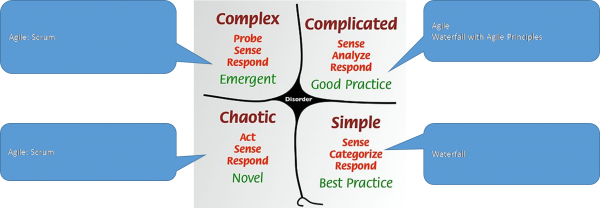In one of my previous blog posts, I discussed using the Cynefin framework for providing guidance in determining the type of healthcare project you will be managing and the best SDLC methodology to use for that project.
The Cynefin framework defines four types of projects:
- Simple
- Complicated
- Complex
- Chaotic
Chaotic projects are the rare project, or not so rare, where the requirements are nebulous at best and execution of the project will consist of building “something” and gaining feedback on that something and continuing.
Think about a healthcare client that wants to implement a data lake because they know they have big data they want to capture in the future but really have no well-defined set of use cases for this endeavor. How would you start? First, you need to know you are in a chaotic project that does not have any real requirements. Then you need to determine the best methodology. The Cynefin framework tells us that Agile: Scrum would be the best choice.
Why? Because by taking advantage of the Agile Manifesto, we are uncovering better ways of developing software by doing it and helping others do it.
Through the Agile Manifesto, the focus is on:
- Individuals and interactions over processes and tools
- Working software over comprehensive documentation
- Customer collaboration over contract negotiation
- Responding to change over following a plan
As the client tries to figure out what they really need, the principles of the Agile Manifesto fit nicely in a chaotic project:
- The highest priority is to satisfy the customer through early and continuous delivery of valuable software.
- Welcome changing requirements, even late in development. Agile processes harness change for the customer’s competitive advantage.
- Deliver working software frequently, from a couple of weeks to a couple of months, with a preference to the shorter timescale.
- Business people and developers must work together daily throughout the project.
- Build projects around motivated individuals. Give them the environment and support they need, and trust them to get the job done.
- The most efficient and effective method of conveying information to and within a development team is face-to-face conversation.
- Working software is the primary measure of progress.
- Agile processes promote sustainable development. The sponsors, developers, and users should be able to maintain a constant pace indefinitely.
- Continuous attention to technical excellence and good design enhances agility.
- Simplicity, the art of maximizing the amount of work not done, is essential.
- The best architectures, requirements, and designs emerge from self-organizing teams.
- At regular intervals, the team reflects on how to become more effective, then tunes and adjusts its behavior accordingly.
Using this approach will focus the customer on a single use case that can then be developed into “something” meaningful for a client.


